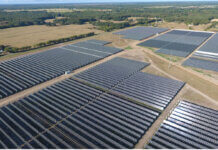The recently released U.S. Energy Storage Monitor report, by the American Clean Power Association (ACP) and Wood Mackenzie, states that across all segments of the industry, in the first quarter of 2023, the U.S. energy storage market added 2,145 MWh, marking a 26% decrease from the fourth quarter of 2022.
The grid-scale segment installed 1,553 MWh in the first quarter of 2023, recording the second-straight quarterly decline and falling 33% below first quarter of 2022 installations, the report also notes.
California and Texas continue to drive the energy storage market, accounting for 84% of activity in the first quarter, but project delays contributed to the diminishing environment.
“The recent energy storage market slowdown illustrates how storage development is already interwoven with new solar and wind projects – and how trade and policy issues in those sectors affect storage deployment,” says John Hensley, ACP’s vice president of research and analytics. “It’s crucial we continue to tackle supply chain and interconnection hurdles.”
Wood Mackenzie has slated forecasted 2023 additions from the grid-scale project pipeline at 8.9 GW and 10.5 GW across all segments. While the forecasted capacity for 2023 decreased slightly quarter-over-quarter (QoQ), total additions for all segments are still expected to double by end-of-year 2023 from 2022.
“This is the first consecutive quarterly decline we have seen in the energy storage market since 2015 when installations were much smaller in volume and more unpredictable,” observes Vanessa Witte, senior analyst with Wood Mackenzie’s energy storage team.
Community, commercial and industrial (CCI) installations bounced back in the first quarter of 2023, after four consecutive quarters of lower-than-average activity. In total, the CCI market installed 203.3 MWh for its second-highest quarter on record and 145% above year-over-year (YoY) numbers.
Residential storage recorded its second-highest quarter on record at 388.2 MWh but there was a decline from the fourth quarter of 2022 installed capacity. This marked the first QoQ decline for the residential sector in nearly two years.
Market declines are a cause for concern but seem to be merely temporary, notes ACP’s Hensley: “The forecast through 2027 is encouraging and we remain confident in the long-term growth trajectory of the sector. The need of energy storage will continue to grow as more clean energy technologies are added to the grid.”




